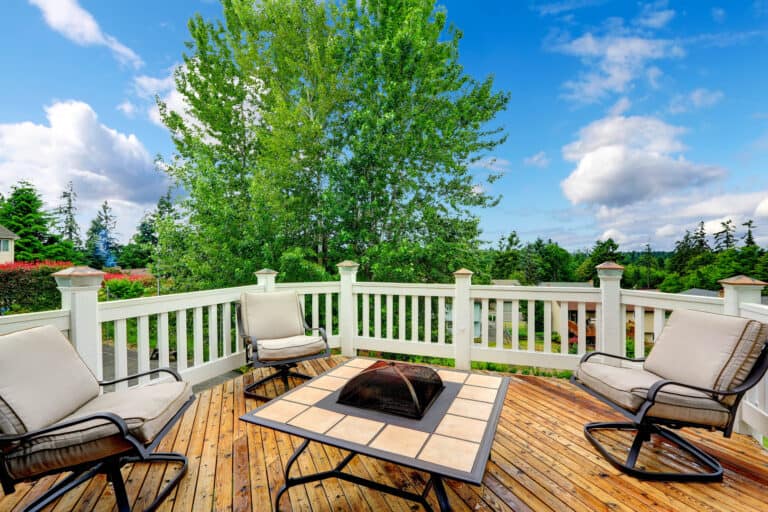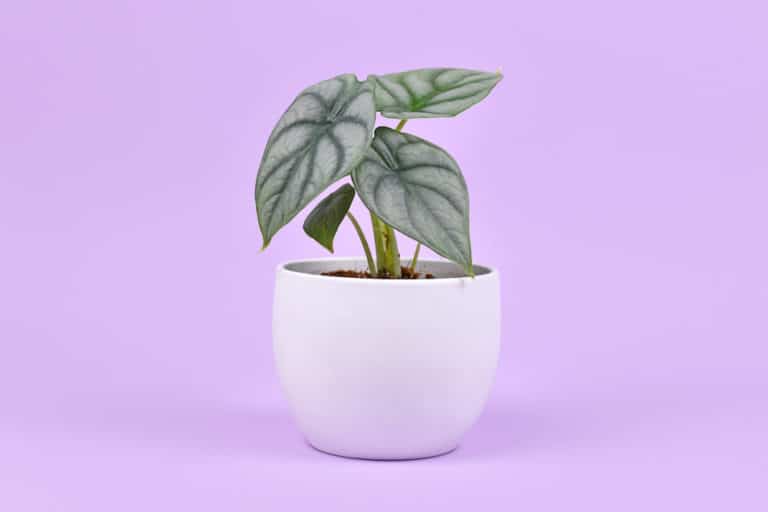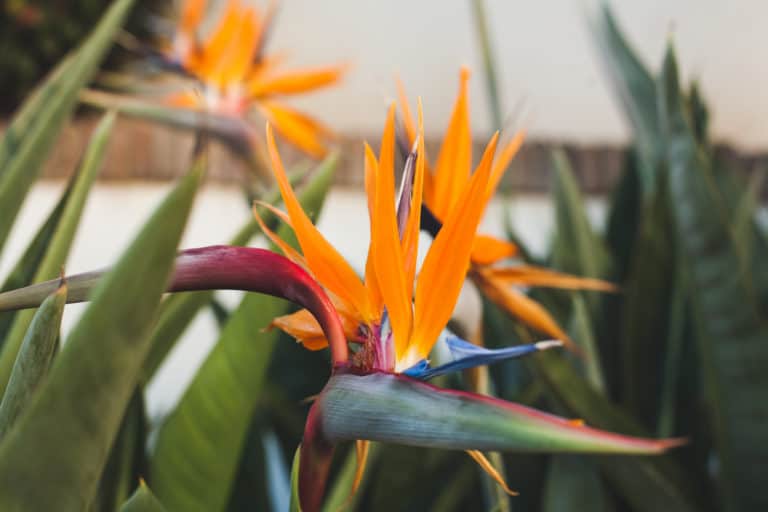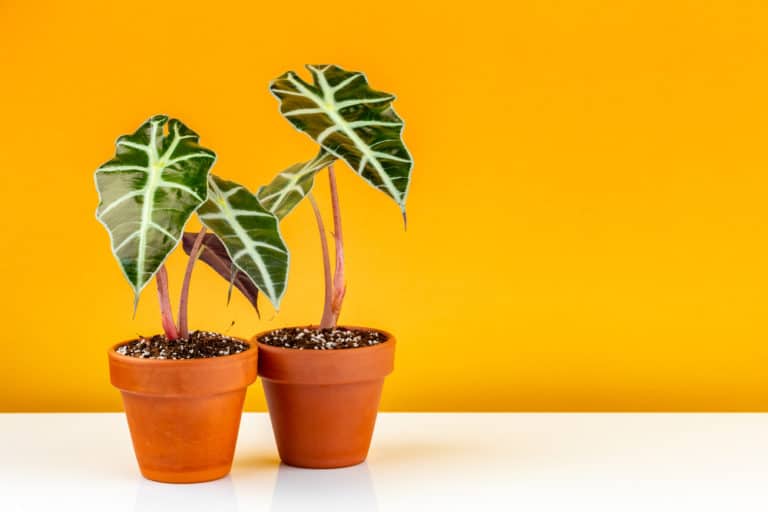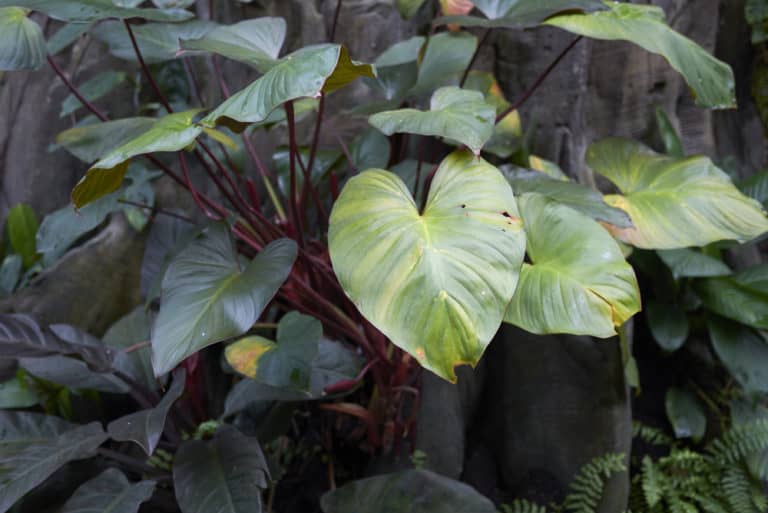Philodendron Billietiae ‘Billie’ Care Guide (2024)

Philodendron billietiae is a relative newcomer to the houseplant scene, but it’s quickly become one of the must-have tropical plants.
While you will have to pay a lot of money for your Billie plant, its long, striking leaves and bright orange stems can be too much to resist.
Perfect for contemporary decor, one of these unique plants will be a real conversation piece.
| Scientific Name | Philodendron billietiae |
| Common Name | Billie and Philidor, Billie |
| Light | Bright indirect sunlight |
| Watering | Water if the top inch of soil is dry |
| Temperature | 65 to 80ºF (18 to 27ºC) |
| Hardiness Zone | 9 to 11 |
| Humidity | 70 to 90% |
| Soil Type | Rich, quick-draining, loamy |
| Soil pH | 6.1 to 7.3 (mildly acidic to neutral) |
| Fertilizing | A balanced feed once a month in spring and summer |
| Repotting | Every 2 years |
| Pruning | To remove dead leaves |
| Propagation | Root in water or soil, or air layer |
| Toxicity | Toxic to humans and pets |
| Mature Size | 36 inches as a houseplant |
| Bloom Time | Rarely flowers indoors |
What’s Unique About Philodendron billietiae?
The Philodendron billietiae plant is a cultivar that was only found in the wild in 1981. It’s native to the rainforests of Brazil, Guyana, and French Guiana. It’s been available to home gardeners since 1995.
Philodendron billietiae plants are notable for their long, narrow leaves and their orange petioles, which have a very modern feel perfect for a sophisticated loft.
Growing Philodendron billietiae isn’t as difficult as you might think, so the steep price for one of these tropical beauties isn’t a huge gamble.
And like all philodendrons, Philodendron billietiae is a natural air purifier, scrubbing contaminants such as benzene and formaldehyde from the indoor air.
Philodendron billietiae Care
In the tropical rainforests of South America where Philodendron billietiae originates, it lives in the dappled shade of the canopy, in warm and humid conditions.
Your Philodendron billietiae plant care needs to reflect those needs.
For good Billie plant care, keep this rare and expensive Philodendron in a warm spot, with as high a humidity level as possible, while protecting it from the sun.
Light
In its native rainforests, Philodendron billietiae is shielded from the direct rays of the hot tropical sun by the trees that grow far above it.
In your home, Philodendron billietiae light requirements are for bright but indirect light, or between 10,000 to 20,000 lux.
You can usually meet these Billie plant light needs without supplementary lighting, but in regions with few hours of sun in the winter, you will need to use a plant light.
Otherwise, your Philodendron billietiae will be happy next to a north or east window, or several feet back from a south or west window.
Full sun will severely damage the leaves, so avoid direct exposure at all costs.
Watering
In the rainforest, Philodendron billietiae needs to have some moisture at all times. In fact, the roots can travel as far as 100 feet in search of water!
In your home, to fulfill its watering needs, you should water Billie plant whenever the top inch or two of the soil has dried out.
For Philodendron billietiae watering, gently pour room-temperature distilled or rain water over the whole soil surface, giving it time to absorb the water.
When you see excess water trickling out the bottom, let it drain, and then empty that water out so the roots will not be in saturated soil.
Temperature
In a nutshell, Philodendron billietiae will thrive in warm to hot temperatures, and suffer or die in the cold.
The Philodendron billietiae temperature range is from 65 to 80ºF (18 to 27ºC). While the best temperature for Billie plant is at the top end of that scale, it will grow fairly happily as low as 65ºF (18ºC). At night, the temperature can drop to 55 ºF (13ºC).
However, Philodendron billietiae has little temperature tolerance below that.
Even in a heated interior, take care to keep your tender tropical away from drafts and cold windows.
Finally, Philodendron billietiae has no winter hardiness at all. Frost and freezing temperatures will kill it.
Humidity
The ideal humidity for Billie plant is between 60 to 80%, like in its native rainforests.
Obviously, you can’t maintain your entire home at that humidity level, but luckily Philodendron billietiae humidity requirements are fairly flexible.
Usually Philodendron billietiae will be content with a humidity level between 40 to 50%, but if you need to create a moister microclimate for your Philodendron billietiae, you have a few good options.
It is possible to mist the leaves of the Philodendron billietiae every day, using distilled water. However, leaving the leaves wet can encourage fungal diseases, so use this method only as a last resort.
Using a pebble tray under the pot, or setting up a small humidifier or diffuser to add moisture to the air are better solutions.
Soil
Philodendron billietiae soil has to both retain a moderate amount of moisture while still draining excess water so that the roots don’t drown.
The acceptable pH level for Billie plant ranges from 6.1 to 7.3, or mildly acidic to neutral.
The simplest soil for Billie plant is just 100% peat moss, which will hold on to enough moisture while at the same time maintaining an open structure.
You can also buy a commercial soil mix especially formulated for aroids.
If you want to make your own soil, combine equal parts of perlite, compost, orchid bark, peat moss, and potting soil.
Fertilizer
You have a few different options when it comes to Philodendron billietiae fertilizer.
Whatever you use, aim for a fertilizer ratio of 3-1-2. Only feed Philodendron billietiae in spring and summer.
The best fertilizer for Billie plant is organic, as chemical fertilizers can damage the roots. You can use a liquid fish fertilizer, or periodically spread a layer of worm castings on the top of the soil.
If you do use liquid chemical fertilizers, dilute them to half the recommended strength and apply right after you’ve watered.
You can also add slow-release granules to the soil every few months instead.
Adding a teaspoon of Epsom salts every couple of months will add extra magnesium. Either dissolve it in the liquid fertilizer, or add it when you are watering.
Potting & Repotting
Philodendron billietiae repotting should be done every 2 years, or when you see roots starting to fill up the pot.
When repotting Billie plant, only go up one pot size, as too much extra room will harm the plant, not help it.
You don’t have to get too picky about what the pot is made of, but it is absolutely essential that it has good drainage.
Use fresh potting whenever you change your Philodendron billietiae pot. In fact, when it has reached its full size, you will need to refresh the soil every couple of years, even if the pot does not change.
Pruning
You do not have to do much Philodendron billietiae pruning.
The main reason for cutting Billie plant is to trim off dead or damaged leaves, which will mar the look of your Philodendron billietiae, and can harbor disease or pests.
This can be done at any time of the year. Cut the leaf’s stem (or petiole) close to the main stem.
If you want to prune Philodendron billietiae to shape it into either a taller or bushier plant, the best time is early spring at the start of the growing season.
Never cut off more than 25% of the plant’s stems in any one year, and always use sharp, sterilized tools to minimize injury to your Philodendron billietiae.
Propagation
There are two main methods of Philodendron billietiae propagation: stem cuttings and layering. Always undertake this process during spring or summer, when the plant is actively growing.
To propagate Billie plant with stem cuttings, select healthy stems with at least 2 nodes, cutting just below the lowest node.
Leave only leaves growing at the tip. Place the cutting in either water or moist planting medium, and keep it warm and humid. Within a month or so you should have a rooted cutting to plant out.
Air layering is a little more complicated. Select a stem node, and wrap moist sphagnum moss around it. Cover that with plastic wrap with holes poked in it, and keep the moss moist.
When roots form, cut the new plant off from the mother plant.
Also, make sure to check out our in-depth philodendron birkin care guide.
Common Problems of Philodendron billietiae
Considering how rare and expensive this tropical newcomer is, there are not too many Philodendron billietiae problems to worry about.
Most problems with Billie plant can be avoided in the first place, or solved, by paying close attention to its preferred growing conditions.
Almost all problems will first be flagged by its leaves, so keep an eye on them.
Pests
There are a few Philodendron billietiae pests to look out for, but it’s easy to prevent the bugs from settling in on your Billie plant.
Wiping down its large leaves with insecticidal soap or neem oil once a month not only keeps them clean and looking good, but also can repel insects.
Fungus gnats are small black flies attracted to damp soil, which you need for your Philodendron billietiae. Stick some yellow sticky traps in the pot to catch adults, and kill the eggs and larvae with a drench of 1 part hydrogen peroxide to 4 parts water.
Aphids are little green flying insects. Remove them with a handheld vacuum.
Mealybugs look like white puffs under the leaves. Use a cotton ball with rubbing alcohol to wipe them away.
Diseases
You really don’t have to worry about many Philodendron billietiae diseases. Especially if you don’t overwater your Billie plant, or let the leaves stay wet, it will be hard for fungal or bacterial diseases to take hold.
Root rot is the most common Philodendron billietiae disease.
This gets started when the soil stays too wet, cutting off the air from the roots. You will observe the leaves turning yellow and the stems getting soft. If you pull out the root ball the roots will be turning black with a foul odor.
Cut off all unhealthy parts and repot your Philodendron billietiae in fresh soil after disinfecting the pot.
Growing Problems
Other growing problems are caused by poor growing conditions. If you can improve them for your precious Philodendron billietiae, your sick plant should make a full recovery.
White, drooping leaves indicate that your Philodendron billietiae is being kept in too cold a location.
V-shaped stains and yellow, wilted leaves are a sign of a magnesium deficiency. As an immediate response, spray the leaves with epsom salts dissolved in distilled water.
Then, add a teaspoon of epsom salts when you water your Philodendron billietiae.
Curled leaf tips can mean low humidity or too much fertilizer. You can flush out excess fertilizer by running a stream of water through the soil for about 10 minutes.
Toxicity of Philodendron billietiae
The Billie plant is toxic to humans and animals.
Its toxicity is because of the calcium oxalate crystals that can be found in all parts of the plant.
The tiny, sharp crystals will pierce delicate tissues and can cause pain in mild exposures, or more serious reactions when a quantity of the foliage has been ingested.
For Humans
Philodendron billietiae is toxic to humans.
Children cannot be expected to keep their hands off of anything that looks interesting, and they may try to eat a leaf.
If they have taken a bite, get them to spit it out and rinse their mouth thoroughly. Wipe off any plant matter on their face to avoid a rash.
If all they have is some localized pain in their lips, give them a soothing treat like a popsicle to numb the pain.
However, if their tongue or airways are swollen, take them to the emergency room at once.
If you get some of the sap on your skin, rinse it off immediately to prevent a rash from developing.
For Pets
Philodendron billietiae poses more of a risk for the pets in your household.
If your cat, dog, or rabbit nibbles on a Philodendron billietiae leaf, and then starts drooling, vomiting, wheezing, or has diarrhea, take it to the veterinarian immediately.
They can end up with significant internal damage if not treated.
Prevent these unfortunate incidents by keeping your Philodendron billietiae out of reach of pets and children alike.
Since it usually only gets 3 feet tall when grown indoors, you can easily place its pot on a high ledge out of reach of all the small inhabitants of your home.
Philodendron billietiae Appearance
The Philodendron billietiae appearance is what has made it so in demand as a fashionable houseplant.
The long, heart-shaped leaves grow in a naturally graceful shape, giving Philodendron billietiae a strong architectural form that is particularly suited to modern interiors.
You will probably never get a Billie plant flower, but with the striking look of its leaves, you won’t miss it.
Foliage
The foliage of Philodendron billietiae is really quite unique, even in the Philodendron family.
Each long, narrow, heart-shaped leaf can grow to between 10 and 22 inches long. As the leaves mature they get a puckered, wavy appearance.
Leaves are a bright, glossy green with a thick, leathery texture. They grow on long orange stems arching out from the main vine.
Each leaf will remain on the plant for quite some time, so it’s important to keep them clean.
When a Philodendron billietiae grows outdoors in a tropical climate, the leaves can reach a really massive size of 3 feet long and 8 inches across.
Flowering
Philodendron billietiae flowering does occur in the wild, but it’s very rare to have a blooming plant indoors.
Philodendron billietiae needs to reach maturity to flower, and that can mean vines up to 90 feet long, which is obviously not going to happen with a potted plant.
When a mature Philodendron billietiae does flower, the blooms are not very spectacular. The spathe is green and white, with some purple touches. The spadix is green and white.
Some growers simply cut off the flowering axils before the blooms emerge. This lets the Philodendron billietiae concentrate its resources on growing the leaves.
Size and Growth
Indoors, the size of Philodendron billietiae is on a much smaller scale than in the wild.
A vine grown in a container can be expected to reach 3 feet in height, possibly up to 5 feet under ideal conditions.
It has a moderately fast growth rate.
The leaves grow faster than the vine as a whole, so even while your Philodendron billietiae is small, it will put on a good foliage show.
Your Philodendron billietiae will grow faster and more upright when given a sphagnum moss pole for support. Its aerial roots will grab onto the pole as it grows upward.
Philodendron billietiae Fragrance
There is no Philodendron billietiae fragrance. Neither the foliage nor the rare flowers have a scent.
However, Philodendron billietiae has some distinct strengths in the air quality department that should more than make up for the lack of scent.
It filters harmful chemicals such as formaldehyde from the air, giving you a healthier (if fragrance-free) indoor environment.
You may actually prefer an unscented plant, especially if you live in a small space where a heavy fragrance could become overwhelming.
As well, some people have a sensitivity or allergic reaction to many different fragrances, so Philodendron billietiae is safe to use in a public space.
Suggested Uses for Philodendron billietiae
Most people grow their Philodendron billietiae indoors, which you have to do if you live anywhere other than a tropical zone.
It’s perfect as an accent plant in a contemporary loft or light-filled beach house, where its dramatic appearance will instantly draw the eye.
Even in a small city apartment, you can tuck it up on a ledge as a modern art piece.
While you have to bring it in as soon as things cool down, you can move your Philodendron billietiae out to a balcony or terrace in the hot summer weather.
Just make sure that you keep it in the shade to avoid burning those magnificent leaves.
FAQ
What is Philodendron billietiae?
Philodendron billietiae is a new Philodendron cultivar that is native to the tropical rainforests of Brazil, Guyana, and French Guiana. Since its introduction in 1995 it has become highly prized.
How to identify Philodendron billietiae?
Philodendron billietiae has long, narrow heart-shaped leaves. They are glossy green and grow on orange stems. The central vine will become quite thick as it matures.
How to care for Philodendron billietiae?
Philodendron billietiae needs to be grown in consistently moist but well-drained soil, and kept in bright but indirect light, in a warm and humid environment.
How to grow Philodendron billietiae indoors?
Philodendron billietiae can be grown indoors as a potted plant, in a warm, bright spot with above average humidity. Water and fertilize the soil regularly.
How to grow Philodendron billietiae outdoors?
Philodendron billietiae can be grown outdoors year-round in zones 9 to 11. In temperate zones it can be moved outdoors to a shady spot in the hot summer weather.
How fast does Philodendron billietiae grow?
Philodendron billietiae has a moderately fast growth rate, although for the most part the leaf production is faster than the growth of the central vine.
How tall does Philodendron billietiae grow?
Philodendron billietiae will grow to a size of 3 feet or so as a houseplant, but when it grows in the wild vines can extend as far as 90 feet.
How to make Philodendron billietiae grow faster?
Philodendron billietiae will grow its fastest when it is staked to a moss pole, and kept in a consistently warm and humid environment, with bright, indirect light.
How to stake Philodendron billietiae?
Philodendron billietiae should be given a sphagnum moss pole to attach its aerial roots to, giving it support as it grows upwards. Rotate the pot regularly to keep it from leaning.
How to pot Philodendron billietiae?
Philodendron billietiae should be potted in a pot with a drainage hole, in soil that will hold adequate moisture while still draining any excess water.
How to revive Philodendron billietiae?
If your Philodendron billietiae is limp and discolored, it may be suffering from too much sun, or not enough. Check the light levels and adjust its position accordingly.
Why is my Philodendron billietiae dying?
Your Philodendron billietiae may have root rot, which will kill it without treatment. Cut off any black, infected roots and affected foliage before repotting it in fresh soil.
Why is my Philodendron billietiae drooping?
Your Philodendron billietiae may be drooping because it has too much water in its soil, or not enough. Either soak it well, or repot it in fresh, porous soil.
How cold can Philodendron billietiae tolerate?
Philodendron billietiae will not tolerate growing in temperatures below 55 ºF (13ºC). Keep it away from drafts and cold windows, and never expose it to freezing temperatures.
How to get rid of pests on Philodendron billietiae?
Philodendron billietiae pests can be prevented or eliminated by wiping down the leaves on both sides every few weeks with neem oil or insecticidal soap.
Is Philodendron billietiae toxic to cats?
Yes, Philodendron billietiae is toxic to cats. If your cat starts wheezing or staggering, or has vomiting or diarrhea, take it to the vet at once.
Is Philodendron billietiae toxic to dogs?
Yes, Philodendron billietiae is toxic to dogs. If your dog starts drooling excessively, or has a swollen mouth and tongue, take it to the veterinarian.
Is Philodendron billietiae toxic to children?
Yes, Philodendron billietiae is toxic to children. If your child has a swollen tongue or constricted airways, they need to go to emergency at once.
Is Philodendron billietiae toxic to humans?
Yes, Philodendron billietiae is toxic to humans. Sensitive individuals can get a rash from the sap, so rinse it off your skin immediately with soap and water.
Does Philodendron billietiae have a scent?
No, Philodendron billietiae has no scent. This makes it a good plant for public settings where some people may have fragrance allergies that can trigger severe reactions.

